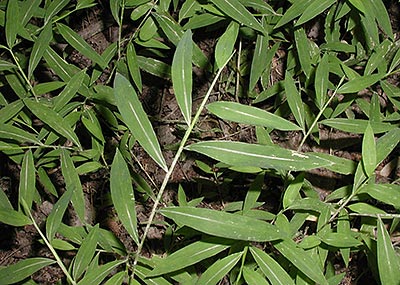 The Michigan Department of Natural Resources recently announced that Japanese stiltgrass, an invasive plant originating in Asia, recently has been positively identified on private property in Scio Township, near Ann Arbor in Washtenaw County. This identification, confirmed by the University of Michigan Herbarium, is the first detection of this species in Michigan.
The Michigan Department of Natural Resources recently announced that Japanese stiltgrass, an invasive plant originating in Asia, recently has been positively identified on private property in Scio Township, near Ann Arbor in Washtenaw County. This identification, confirmed by the University of Michigan Herbarium, is the first detection of this species in Michigan.
Japanese stiltgrass (Microstegium vimineum) has been on Michigan’s invasive species watch list since 2015 due to the grass’s presence in nearby states, including Indiana, Illinois and Ohio. The species is believed to have arrived in the U.S. from Asia in the early 20th century, when it was used as a packing material for fine china. It is now widely distributed along the East Coast and in southern states.
Why be concerned?
“This annual grass is considered highly invasive, taking hold in areas of disturbed soil along banks, roadways and woods,” said Greg Norwood, invasive species coordinator for the DNR’s Wildlife Division. “Seeds can be transported by water or on animals, and seeds can remain viable in the soil for 3 to 5 years. Because deer don’t feed on Japanese stiltgrass, it often takes over in areas where deer browse on native plants and leave open patches of soil.”
What is being done?
The DNR is collaborating with The Stewardship Network, a nonprofit conservation group based in Ann Arbor, and other partners to identify the extent of the infestation. To date, small “satellite” populations have been located on the original property and a nearby site. The primary infestation was treated with herbicide, and plant material was burned. The small patches of grass at the satellite locations were removed by hand and disposed of.
How can you help?
The DNR is asking anyone to be on the lookout for Japanese stiltgrass and to report the location and photos of any suspected findings to Greg Norwood at norwoodg@michigan.gov.
Japanese stiltgrass looks like some native grasses, so it may not appear out of the ordinary to the general observer. Here is what to look for:
• A thin, bamboo-like grass with jointed stems and well-spaced leaves.
• Smooth green leaves 2 to 3 inches long and one-half inch wide, tapering to points at both ends, often with an off-center silver stripe or mid-rib.
• 1- to 3-foot-high beds of grass, with some stems running across the ground and others shooting upright.
• Roots, both at the base and stem joints, that are weakly attached to the soil and easy to pull up.
• One to three slender, green flower spikes at the stem tips, appearing in August or September.
Look-alike species
There are a few common plants in Michigan that easily may be mistaken for Japanese stiltgrass.
More information about invasive species, including identification information for Japanese stiltgrass, can be found at www.michigan.gov/invasivespecies.
